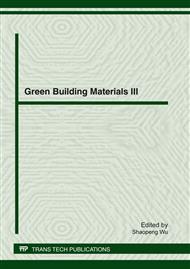p.303
p.308
p.314
p.321
p.328
p.333
p.339
p.346
p.353
Rheological Characteristics of Residue Binder from Low Penetration Grade Bitumen Emulsion
Abstract:
In this study, residue binders from low penetration grade bitumen emulsions were investigated on the basis of rheology and were compared to the neat bitumen binders of which they were produced. The recovery method proposed by EN 13074 (including both recovery and stabilization process at moderate temperatures) was selected to obtain the residue binders used in the analysis, and the corresponding neat binders were treated the same for comparison. The rheological properties of residue binder from low penetration grade bitumen emulsion were evaluated using Dynamic Shear Rheometer (DSR). During the curing process, three stages were divided, and master curves of complex modulus and phase angle were constructed to allow comparison of the residue binder over a large range of frequencies for each stage. The results showed that the complex modulus increases while the phase angle decreases with curing process for the residues, indicating a better performance in terms of elasticity and stiffness.
Info:
Periodical:
Pages:
328-332
Citation:
Online since:
April 2012
Authors:
Price:
Сopyright:
© 2012 Trans Tech Publications Ltd. All Rights Reserved
Share:
Citation:


